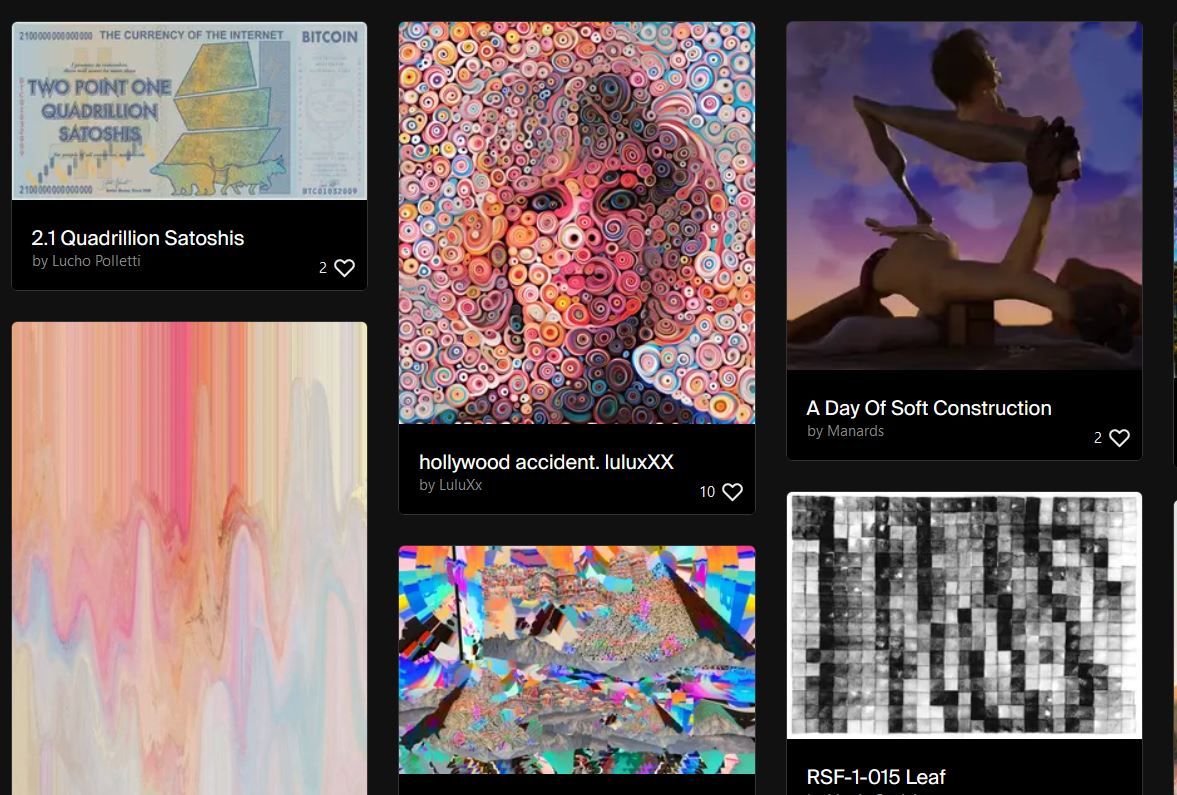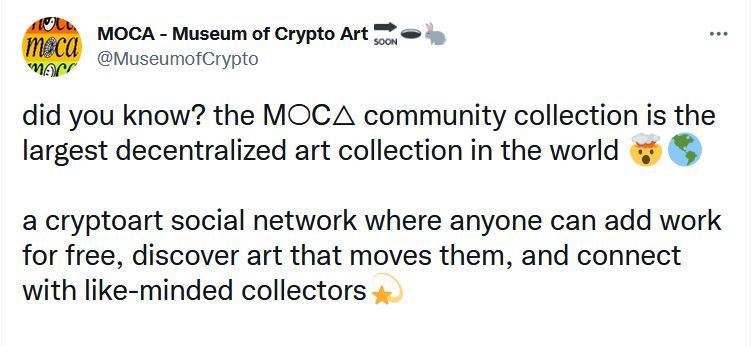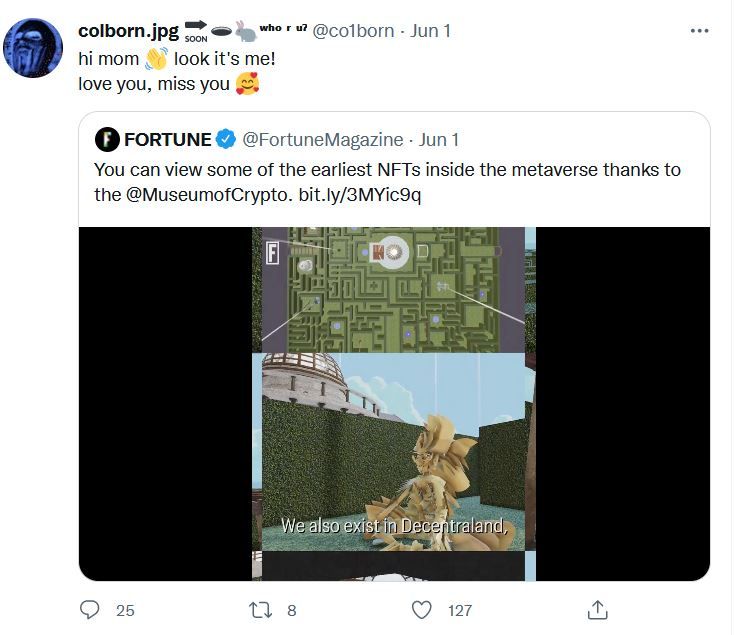A Museum for the Metaverse: Interview with Colborn Bell from MOCA
The Museum of Crypto Art, or MOCA, as it’s better known, is one of the premier art galleries in the crypto space. MOCA has a mission of collecting notable art from crypto history and making it completely accessible, for free, to the public. This week, I had a chat with Colborn Bell, co-founder and director of MOCA, about MOCA’s past, present, and future in the crypto art space.
This interview has been edited for length and clarity.
How do you see NFTs innovating the art world?
I think the same abstraction that Bitcoin did to the banking system in terms of value, self-sovereignty and more collective decision-making around value is what is happening [in NFTs]. I think broadly, I recognize a large shift in intergenerational preferences to the digital. I anticipate people will want to travel more and own less things, and removing the physicality from art and culture ultimately allows individuals to be more free and makes it more accessible.

I see a very visual global culture developing, one that is outside this very white, male, Euro-centric traditional art canon, and the forces that continue to prop that up. So I am interested in how we move to that oneness of global culture and recognizing and uplifting voices from all over.
It obviously flattens the ability to access, and in a place like Argentina, where they might not have the production capabilities of somebody in the US or in Europe, they can go pirate online tools or they can get very creative with how to access whatever tool they’re using, and they have the ability to self-teach and learn. A lot of my favorite artworks generally come from the margins, from people who have hacked together over many years this very unique and interesting and compelling process and perspective.
How did the Museum of Crypto Art come about?
I was introduced in January 2020 to SuperRare as a potential equity investment. I had been familiar with the Editional app, so this concept of one-of-one artwork was not foreign to me. In doing due diligence there, I jumped into the platform and fell in love with what I saw. I placed some bids and I woke up the next morning and people had accepted those bids. In getting to know those people, I recognized that something really special was happening.

It was also in January that Decentraland officially launched, so I saw the way that people were using these online virtual spaces. I came across Somnium Space and fell in love with the aesthetic and decided to pair that virtual world and these artworks.
In April 2020, the museum launched. Since then, we’ve done over 40 online and IRL exhibitions, and the museum has grown tremendously in a short period of time.
How do you feel about this fast growth?
It’s been sweet. It reminds me so much of 2017 and the ICO boom. At the end of the day, we’re a Museum of Crypto Art, so I look for cultural expression that speaks to the core philosophies that attracted me to cryptocurrency in the first place. The word “NFT” has become such a vague and meaningless wrapper as to encompass everything, from profile pictures to blockchain gaming, and I get why, when people hear “NFT,” they think it’s so vapid and hollow and don’t recognize that there is art here.
Of course, there’s a lot of misinformation, a lot of confusion. But whenever I get discouraged, I return to those original voices, those original curators, and immediately draw from a tremendous well of inspiration. They’re still fighting for the same things they were fighting for in 2017, except with more of a platform and more understanding of why this is an interesting and compelling medium for artists to fight for their own sovereignty.
Tell us about MOCA’s collection.
The collection we’re building right now is called the Genesis collection. It’s a subset of the permanent collection. Right now it contains 230 works from 230 different artists: one piece from one artist who minted prior to December 2020. That is the broadly accepted marker of when this turned from an ideological revolution to more of a market-focused venture. It’s really meant to give those early pioneers and innovators their space in this museum.
Of those 230 pieces, I contributed maybe 150 of those from my personal collection. Everything in that collection is owned by the museum as a foundation. This has very little to do with me. Every day, the museum continues to decentralize. Twenty other collectors have provided those remaining 80 pieces. That collection will remain open forever, allowing anybody to have their rightful spot in the timeline of what was created.

It’s really not meant to play favorites of who is the best or who is creating but taking note that everybody standing together really shook the world. In that way, it’s a post-form and post-aesthetic collection that focuses on the collective power of these individuals and the vision that they had to participate so early. I think that is really the art, the ability to take risks and to believe in something greater and more powerful, even when there’s very little economic incentive to do so.
I’m curious about how the museum works. Aside from being virtual, how do you differ from a traditional art gallery?
Nothing is for sale by mandate of the foundation. None of the works will ever be or can ever be for sale. The way we sustain ourselves is every day we sell a room, and this is a room of the museum that is meant to invite in other curatorial voices and focus on showcasing the breadth and depth [of crypto art]. We’re trying to invert the classic power structure of these museums, [where] there is one curator and they make all the decisions and they design all the shows, and they’re beholden to a board of directors.
Our mission at MOCA is really to decentralize the whole thing, so that we’re not beholden to the money and power but beholden to the community of artists that we work on behalf of and the real art patrons and sponsors who care about the space and its ideological purity.
What has the reaction been from the trad art world?
It’s certainly been mixed. Obviously the traditional art world has been trying to move digital, especially during coronavirus. I don’t think many people see it as direct competition. It’s still at the stage where they might see it as a cute little experiment.

We’ve gotten wonderful media attention from the New York Times, Wall Street Journal, Forbes, Fortune, Art Net. So I think the traditional art world is still trying to wrap their heads around this. Because it is a very deep and conceptual project wrapped in an easy mental model of a museum, they take more of a slower, “let’s wait and see” approach and in the interim play friendly.
What’s the roadmap for the future of MOCA?
I think we are very close to it being almost fully autonomous. We have a super interesting AI virtual curator logic build. This will allow anybody to go into the museum and ask about artwork on the walls and ask about artists’ stories and maybe hear some historical stories from a time when they weren’t present in the space. That should go live soon. Our Rooms feature will go live soon. We have the ability for people to upload and curate. We built that tech out.

I think it will continue to be a brand-building exercise and an exercise in getting more people to use our software. We have 3600 active users on the website who have uploaded pieces, and we have 6600 pieces in the community collection and almost 53,000 NFTs that have been activated, so it’s just about pulling more people in and figuring out what are the communities that care and who is going to persist over time and be a meta-aggregator of this space from a non-commercial perspective. And using our tools to reflect the values of the artists.
Frankly, there’s no reason why it can’t be one of the largest metaverse museums run by a global cooperative of artists and art patrons and people who care about this new format.
Call it a museum, but it’s really the opposite. An innovation tank and a safe space for people to come and create freely.
You can find the Museum of Crypto Art at museumofcryptoart.com, or visit the dApp. For updates on events and exhibitions, follow the Museum of Crypto Art on Twitter, and find all the virtual spaces they’re at at y.at.
Read more:
Interview with Artnome, and His Fight to Save Your NFTs
Interview with Carlini8, OG of Web3
Barthazian Interview


